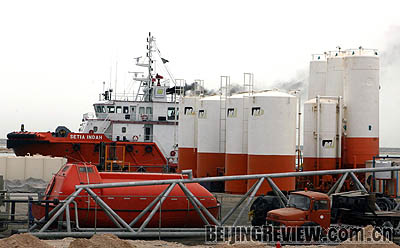|

FILLING THE GAP: To ensure sustainable energy supplies, China will buy liquefied natural gas (LNG) from Qatar, the largest LNG producer in the world
LIN SU
Two of China's biggest oil companies inked major long-term deals on April 10 to buy liquefied natural gas (LNG) from Qatargas Operating Co.
In the first deal, Qatargas and its partner, Shell Oil Corp., agreed to sell 3 million tons of LNG annually to China National Petroleum Corp. (PetroChina), China's largest natural gas supplier, from 2011 to 2034. In the second one, China National Offshore Oil Corp. (CNOOC), the country's biggest owner of LNG terminals, agreed to purchase 2 million tons of LNG from Qatargas annually for projects in Guangdong, Fujian and Zhejiang provinces and Shanghai.
The parties involved in the deals declined to disclose how much the contracts are worth. But given LNG's current price of 6,500 yuan ($929) per ton in China, the deals are by no means small ones.
"A tie-up with Qatar, a world-leading LNG producer, will propel the diversification of China's energy supplies," Jiang Jiemin, Chairman of PetroChina, said at the deal's signing ceremony. "The clean-burning fuel will also breathe steam into the rapid and sustainable development of the Chinese economy. We are looking forward to a long-term mutually beneficiary partnership with Qatar."
Both agreements come at a time when China predicts it will have an LNG deficit of 80 billion cubic meters by 2020. Over the past few years, the Chinese Government has told its oil and gas companies to intensify their search for energy resources to meet the country's rising consumption, driven by its rapidly growing economy. China has been importing LNG for several years as an alternative fuel source, especially to its coastal provinces. Prior to the two new deals, PetroChina and CNOOC had landed long-term LNG contracts with Australia, Indonesia and Malaysia. CNOOC also has been holding talks with Iran to secure additional supplies of the fuel.
Located on the southwest coast of the Persian Gulf, Qatar is a treasure trove of both oil and natural gas. Its 25-trillion-cubic-meter natural gas reserves are the third largest in the world. The country is the world's largest LNG exporter, and it is expected to produce 77 million tons annually in 2010. In the past, Qatar exported most of its natural gas to the United States and European countries. But as international oil prices have continued to spiral upward, heavy energy consumers in Asia, including China, Japan and South Korea, have increased their demand for LNG as an alternative fuel source.
In the two deals with China, the development field at the Qatargas 4 project will supply LNG to PetroChina and CNOOC. It will transport gas to PetroChina's receiving terminal after the Qatargas project and Chinese terminal start operating commercially. Currently under construction, the Qatargas 4 project is a joint venture of Qatargas and Shell, each of which holds 70 percent and 30 percent stakes, respectively.
Deemed a clean energy source that could replace oil, natural gas has been on a roll in the market in recent years, as reflected by its rocketing price. This puts China in a tight spot, because it already has been choked by natural gas deficiencies.
"Domestic gas fields are largely small ones, difficult and costly to explore," Liu Xiaoli, Deputy Director at the Research Center of Energy Economy and Development Strategy under the National Development and Reform Commission, told Economic Information Daily.
Natural gas accounts for only 2.8 percent of China's primary energy consumption, while it accounts for 23 percent of world consumption, Liu said in the article.
"Besides this, uneven allocations of the country's natural gas resources also put China's natural gas supplies at stake," Liu was quoted as saying.
China's natural gas resources are clustered mainly in the north, but consumed mostly by central areas. Large cities located along LNG pipelines receive ample supplies of the fuel, but remote small and medium-sized cities do not.
As a result, China has had to resort to importing LNG. The latest data from the General Administration of Customs indicate that the country imported 2.9 million tons of LNG in 2007, or 6,000 times the amount that it imported in 2005 when a minimum of 483 tons came from abroad. This accounted for 41.7 percent of China's total imports of liquefied petroleum gas in 2007.
China will have to rely more on LNG imports in the future. The Ministry of Land and Resources has forecast that China's demand for natural gas will reach 110 billion cubic meters in 2010, but it believes the country will be able to produce only 90 billion cubic meters itself. By 2015, the ministry forecasts that demand will swell to 160 billion cubic meters, with the country producing only 120 billion. By 2020, the LNG shortage will amount to 80 billion cubic meters, equal to 60 million tons of the fuel. | 